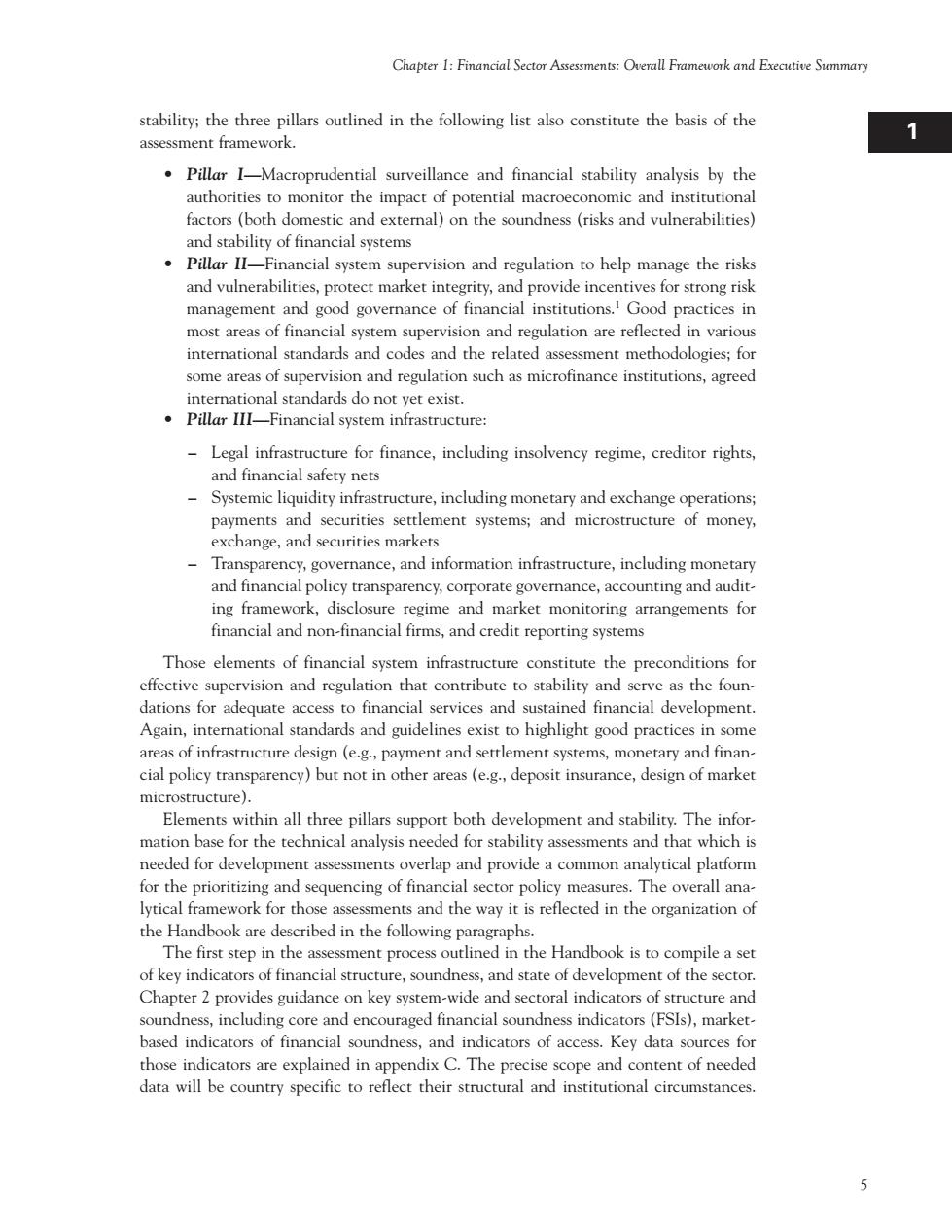正在加载图片...

Chapter 1:Fimancial Sector Assessments:Overall Framework and Executive Summary stability;the three pillars outlined in the following list also constitute the basis of the assessment frameworl 1 .Pillar I-Macroprudential surveillance and financial stability analysis by the authorities to monitor the impact of potential macroeconomic and institutiona factors(both domestic and extemnal)on the soundness (risks and vulnerabilities) and stability of financial systems Pillar II-Financial system supervision and regulation to help manage the risks and vulnerabilities,protect market integrity,and provide incentives for strong risk manageme and go ood governa nce of fir ncial institutions.Good most areas of financial system supervi and regulation are reflected international standards and codes and the related assessment methodologies;for some areas of supervision and regulation such as microfinance institutions,agreed international standards do not yet exist. .Pillar III-Financial system infrastructure: Legal infrastructure for finance.including insolvency regime.creditor rights and financial safety nets Systemic including mone and exchange operations payments anc systems;and microstructure of money exchange,and securities markets Transparency,governance,and information infrastructure,including monetary and financial policy transparency,corporate governance,accounting and audit. ing framework,disclosure regime and market monitoring arrangements for financial and non-financial firms,and credit reporting systems Those elements of financial system infrastructure constitute the preconditions for effective s on and reg lati ibute to stabilit and s the foun acce services and sust d financial developmen Again,international standards and guidelines exist to highlight good practices in some areas of infrastructure design (e.g.,payment and settlement systems,monetary and finan- cial policy transparency)but not in other areas (e.g.,deposit insurance,design of market nicrostructure) Elements within all three pillars support both development and stability.The infor- mation hase for the technical analysis eded for stabilit n and that which is needed for development assessr nents and provid a common ar ytical platform The overall ana lytical framework for those assessments and the way it is reflected in the organization of the Handbook are described in the following paragraphs. The first step in the assessment process outlined in the Handbook is to compile a set of key indicators of financial structure,soundness,and state of development of the sector Chapter 2 provides guidance on key system-wide and sectoral indicators of structure and sound ncluding core and enco ndness indicators(FSIs),market based indi cators of financial soundness an d indicators of access.Key data those indi icators are explained in appendix C.The precise scope and content of neede data will be country specific to reflect their structural and institutional circumstances. 5 Chapter 1: Financial Sector Assessments: Overall Framework and Executive Summary 1 I H G F E D C B A 12 11 10 9 8 7 6 5 4 3 2 stability; the three pillars outlined in the following list also constitute the basis of the assessment framework. • Pillar I—Macroprudential surveillance and financial stability analysis by the authorities to monitor the impact of potential macroeconomic and institutional factors (both domestic and external) on the soundness (risks and vulnerabilities) and stability of financial systems • Pillar II—Financial system supervision and regulation to help manage the risks and vulnerabilities, protect market integrity, and provide incentives for strong risk management and good governance of financial institutions.1 Good practices in most areas of financial system supervision and regulation are reflected in various international standards and codes and the related assessment methodologies; for some areas of supervision and regulation such as microfinance institutions, agreed international standards do not yet exist. • Pillar III—Financial system infrastructure: – Legal infrastructure for finance, including insolvency regime, creditor rights, and financial safety nets – Systemic liquidity infrastructure, including monetary and exchange operations; payments and securities settlement systems; and microstructure of money, exchange, and securities markets – Transparency, governance, and information infrastructure, including monetary and financial policy transparency, corporate governance, accounting and auditing framework, disclosure regime and market monitoring arrangements for financial and non-financial firms, and credit reporting systems Those elements of financial system infrastructure constitute the preconditions for effective supervision and regulation that contribute to stability and serve as the foundations for adequate access to financial services and sustained financial development. Again, international standards and guidelines exist to highlight good practices in some areas of infrastructure design (e.g., payment and settlement systems, monetary and financial policy transparency) but not in other areas (e.g., deposit insurance, design of market microstructure). Elements within all three pillars support both development and stability. The information base for the technical analysis needed for stability assessments and that which is needed for development assessments overlap and provide a common analytical platform for the prioritizing and sequencing of financial sector policy measures. The overall analytical framework for those assessments and the way it is reflected in the organization of the Handbook are described in the following paragraphs. The first step in the assessment process outlined in the Handbook is to compile a set of key indicators of financial structure, soundness, and state of development of the sector. Chapter 2 provides guidance on key system-wide and sectoral indicators of structure and soundness, including core and encouraged financial soundness indicators (FSIs), marketbased indicators of financial soundness, and indicators of access. Key data sources for those indicators are explained in appendix C. The precise scope and content of needed data will be country specific to reflect their structural and institutional circumstances